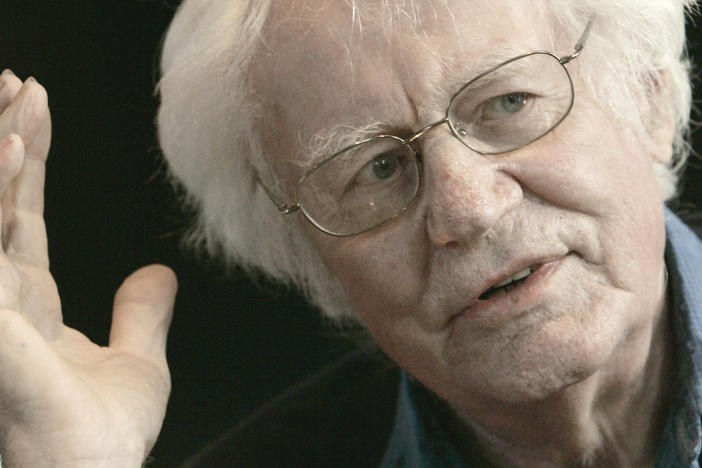Section Branding
Header Content
Writer Joan Didion, whose 'electric anxiety' inspired a generation, has died at 87
Primary Content
When Didion started writing in the 1960s, she put a certain kind of voice on the page — neurotic, female — that hadn't been there before.
Transcript
ARI SHAPIRO, HOST:
The American novelist, journalist and essayist Joan Didion died today at her home in New York. The cause was complications from Parkinson's disease, according to a statement from her publisher. She was 87. The bestselling writer began describing her original home state, California, for magazines in the 1960s and broadened her subjects over the decades in nonfiction, fiction and films. NPR special correspondent Susan Stamberg has this remembrance.
SUSAN STAMBERG, BYLINE: Joan Didion spoke about the act of writing more astutely than pretty much anybody else.
(SOUNDBITE OF ARCHIVED RECORDING)
JOAN DIDION: I write entirely to find out what is on my mind, what I'm thinking.
STAMBERG: The writing itself the path to understanding, clarification. Here's Didion's definition of a writer.
(SOUNDBITE OF ARCHIVED RECORDING)
DIDION: A person who's most absorbed and passionate hours are spent arranging words on pieces of paper.
STAMBERG: She said that in 1976, in a speech at her alma mater, the University of California, Berkeley. By then, Didion had published "Slouching Towards Bethlehem," a collection of reportage about life in the chaos of 1960s America. And she'd done two novels, "Play It As It Lays" - Lost in Las Vegas and Most Other Places could be a subtitle - which followed her debut novel "Run, River." Didion reads an excerpt from that.
(SOUNDBITE OF ARCHIVED RECORDING)
DIDION: (Reading) There was a sense that to close one's eyes on a Valley town was to risk opening them a moment later on dry fields, the sun leaching out the last traces of habitation - a flowered straw hat, a neon advertisement which had blinked a moment before from a wall no longer visible. It was a great comfort watching the towns come and go through the tinted windows of the Greyhound bus. The heat drained the distinctions from things - marriage and divorce, and new curtains and overdrafts at the bank - all the same. And Lily could not at the moment imagine any preoccupation strong enough to withstand the summer.
STAMBERG: That excerpt from 1963 is the essence of Didion's writing style - terse, polished, elegant, piercing. Reviewer John Leonard said her sentences were like icepick laser beams. Novelist and non-fiction writer Francine Prose says in the '60s, Didion pioneered that style, that voice.
FRANCINE PROSE: It's hard to remember how important it was to see evidence of real female intelligence on the page. She put a certain kind of voice - Western, female, anxious - on the page that hadn't been there before.
STAMBERG: Francine Prose made a list of all the places and subjects Didion dealt with in her writing lifetime.
PROSE: California, central California, Los Angeles, San Francisco, New York, Hawaii, El Salvador, Las Vegas, Miami, John Wayne, Patty Hearst, Vietnam, the Central Park jogger, the Black Panthers, presidential elections, Newt Gingrich, Doris Lessing, feminism, hippies, films, books, journalisms and its failures.
STAMBERG: And death of her husband in 2003. "The Year Of Magical Thinking" was her book about that. Two years later, their daughter Quintana died. "Blue Nights" struggled with that subject. Behind all those topics and places was the steady, astute, mournful, anxious voice of the writer.
PROSE: Oh, sure. It's just thrumming with anxiety that - every sentence has a kind of electric anxiety, and it's partly what makes you pay such close attention. I mean, you're just waiting for something to explode. And then it doesn't, and you keep reading.
STAMBERG: Just as Didion, with her nervous pen, kept writing, itself an act of bravery.
PROSE: Everything makes her anxious, and yet she goes to Salvador, she goes to Miami, she goes to Las Vegas, she travels all around California, she visits the Panthers, she visits the hippies. It's anxiety, and it's, the same time, transcending the anxiety, which pretty much describes what it takes for any of us to get through the day.
STAMBERG: Didion admitted that the landscapes, physical and psychological, which she described were desolate.
(SOUNDBITE OF ARCHIVED RECORDING)
DIDION: I am more attracted to the underside of the tapestry. I tend to always look for the wrong side, the bleak side. I mean, I have since I was a child. I mean, I have no idea why. I've never - talk about unexamined lives, so, I mean...
STAMBERG: We tell ourselves stories in order to live, Joan Didion said. The ones she told were dark truths.
(SOUNDBITE OF ARCHIVED RECORDING)
DIDION: I'm rather a slow study, and I came late to the apprehension that there was a void at the center of experience.
STAMBERG: Before moving to New York City in the 1980s, Didion and her husband, John Gregory Dunne, spent years in Los Angeles. There, together, they wrote screenplays - "Panic In Needle Park," "A Star Is Born," the Barbra Streisand remake, "Up Close & Personal," with Robert Redford and Michelle Pfeiffer as reporters in various TV newsrooms.
(SOUNDBITE OF FILM, "UP CLOSE AND PERSONAL")
MICHELLE PFEIFFER: (As Tally Atwater) You used to cover the White House.
ROBERT REDFORD: (As Warren Justice) You going to tell me you watched me in high school?
PFEIFFER: (As Tally Atwater) No. You're the one who asked George Bush how, as former CIA director, he didn't know Noriega was on the CIA payroll. And Bush said no questions at photo op, and Marlin Fitzwater said pull the lights, and you put the whole thing on the air. It was in a course I took.
REDFORD: (As Warren Justice) You still get the coffee.
STAMBERG: As screenwriters, as well as novelists and journalists, Didion and Dunne were part of the Hollywood establishment. But Francine Prose says you never feel the movie star-ness (ph) of Southern California in Didion's writing, especially not in her personal essays.
PROSE: You do feel that neurotic presence, the person struggling to meet the deadline, the person with the migraine, the person who can barely get out of bed in the morning, the person for whom writing is a kind of torment, the person for whom just the California light is almost too much to bear.
STAMBERG: This all sounds so down, but Joan Didion herself, until the last years, denied any personal fragility assumed by her readers. In real life, she was small, quite thin, pale and un-California-looking. But in 1977, Didion said her physical size was deceptive.
(SOUNDBITE OF ARCHIVED RECORDING)
DIDION: I mean, I'm very healthy. I eat a lot. I don't cry a lot (laughter), you know?
STAMBERG: And she wrote a lot, relying in her fiction on images, pictures, which she said came into her mind. Didion the writer always needed to figure out what was going on in them.
(SOUNDBITE OF ARHIVED RECORDING)
DIDION: If you lie low enough and stay quiet enough and if you don't talk to very many people and you keep your central nervous system from shorting out, these pictures come to you. And then you try to find out what they mean.
STAMBERG: A generation of journalists, in particular, were influenced by those explorations. A generation of fiction and memoir readers were drawn in and enlightened. Joan Didion, a chronicler of cultural truths and fictions, observed her world intensely. She provided clarity.
I'm Susan Stamberg, NPR News.
(SOUNDBITE OF KAKI KING'S "SAD AMERICAN") Transcript provided by NPR, Copyright NPR.
Bottom Content



